Thien Mu Pagoda, an ancient and sacred symbol of dreamy Hue, has long been a must-visit destination when exploring the former imperial city. Not only does it possess unique, serene architecture, but Thien Mu Pagoda is also associated with numerous mysterious historical tales and legends, attracting pilgrims and tourists from all directions to visit and admire. Join “Du lịch khắp thế gian” to explore this “First Ancient Pagoda” and feel its timeless beauty and the peace of Buddha’s sanctuary.
1. Thien Mu Pagoda Hue: A Spiritual Destination Not to Be Missed
Thien Mu Pagoda, also known as Linh Mu Pagoda, is located on Ha Khe Hill, Kim Long ward, Hue city, reflecting its image in the romantic Perfume River. With over 400 years of history, the pagoda is not only a unique religious architectural work but also an indispensable part of Hue’s cultural and historical tapestry. Visiting Thien Mu Pagoda, tourists will admire its ancient, tranquil beauty, discover mysterious stories, and feel the intersection of nature and spirituality.

1.1. Historical Imprints Through Ups and Downs
Thien Mu Pagoda was built in 1601 by Lord Nguyen Hoang, the first lord of the Nguyen Dynasty. According to historical records, during a trip along the Perfume River, Lord Nguyen Hoang encountered Ha Khe Hill, shaped like a dragon turning its head. Believing this was a sacred land, he ordered the construction of a pagoda facing the Perfume River and named it Thien Mu, with the wish to pray for the prosperity of the Nguyen lineage.
Throughout many historical periods, Thien Mu Pagoda has witnessed countless ups and downs of the country. Under the Nguyen Dynasty, the pagoda was restored and expanded many times, becoming one of the largest and most beautiful pagodas in Hue. During the reign of King Tu Duc, the pagoda was renamed Linh Mu because the king wished for a son to succeed him. However, the pagoda was later returned to its original name, Thien Mu. To this day, people are still familiar with both names.

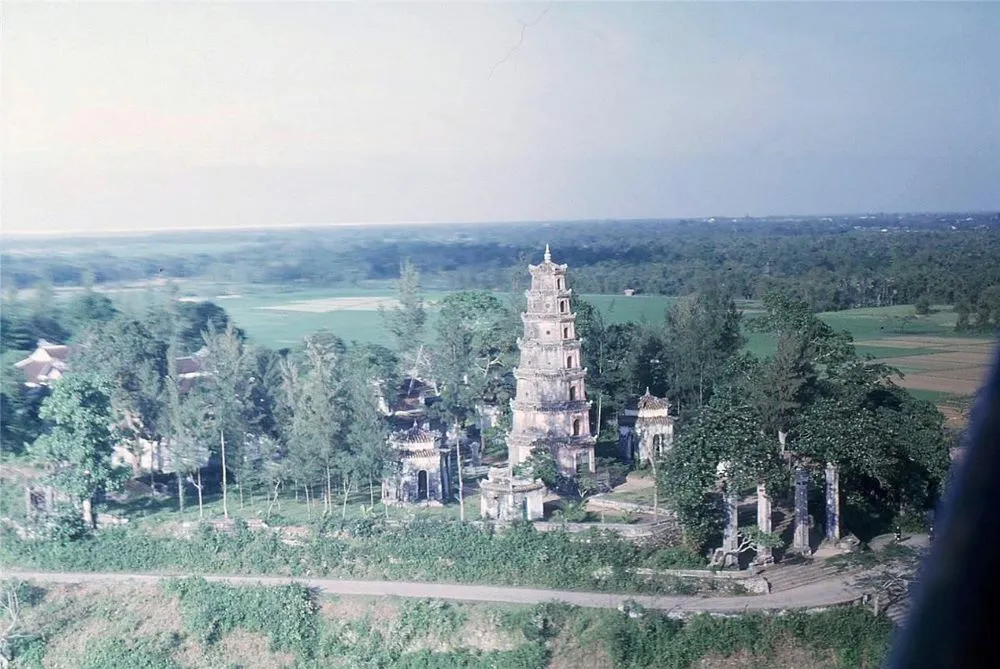
A significant contribution to the pagoda’s development came from Lord Nguyen Phuc Chu, who commissioned the casting of a large bell weighing over two tons and renovated many important architectural works such as the Thien Vuong Palace, the Thuyet Phap House, and the Tang Kinh Pavilion. In particular, the Lord also purchased more than 1,000 sets of Buddhist scriptures from China to store in the Tang Kinh Pavilion, contributing to the revival of Buddhism in Dang Trong.
1.2. Mysterious Stories and the Love Curse
Besides its long history, Thien Mu Pagoda is also famous for its mysterious stories and the love curse. Legend has it that in the past, there was a couple deeply in love, but their families did not approve. In despair, they committed suicide together at the boat wharf near the pagoda. The boy died, but the girl was rescued and later married a wealthy man. The boy’s soul, filled with resentment, turned into a curse that any couple in love who visits Thien Mu Pagoda will be separated.
However, the monks at Thien Mu Pagoda affirm that this curse is not real. The story was spread to warn couples against inappropriate behavior in a sacred place, maintaining the pagoda’s tranquility. If your love is sincere and you respect the sacredness of Buddha’s sanctuary, the curse will not be effective.
2. Directions to Thien Mu Pagoda
Thien Mu Pagoda is located about 5km from the city center of Hue, making it very convenient to travel to. Tourists can choose from various means of transportation such as:
- Motorbike: This is a popular choice for many tourists due to its convenience and flexibility. From the city center, follow Dang Thai Than Street, turn left onto Yet Kieu Street, then turn right onto Le Duan Street. At the roundabout, turn right onto Kim Long Street and go about 2km to reach Thien Mu Pagoda.
- Taxi: Taxis are a fast and comfortable option, suitable for large groups or families with young children.
- Cyclo: Cyclo is an interesting experience to explore the ancient beauty of Hue. You can hire a cyclo from the city center and leisurely admire the scenery on the way to Thien Mu Pagoda.
- Boat on the Perfume River: A unique option is to rent a boat on the Perfume River to get to Thien Mu Pagoda. You will be able to admire the poetic scenery on both sides of the river and feel the peace of life here.
3. Ideal Time to Visit the Pagoda
You can visit Thien Mu Pagoda at any time of the year. However, the best time is from January to March. At this time, the weather in Hue is cool and pleasant, very suitable for sightseeing and exploring other destinations in the city.
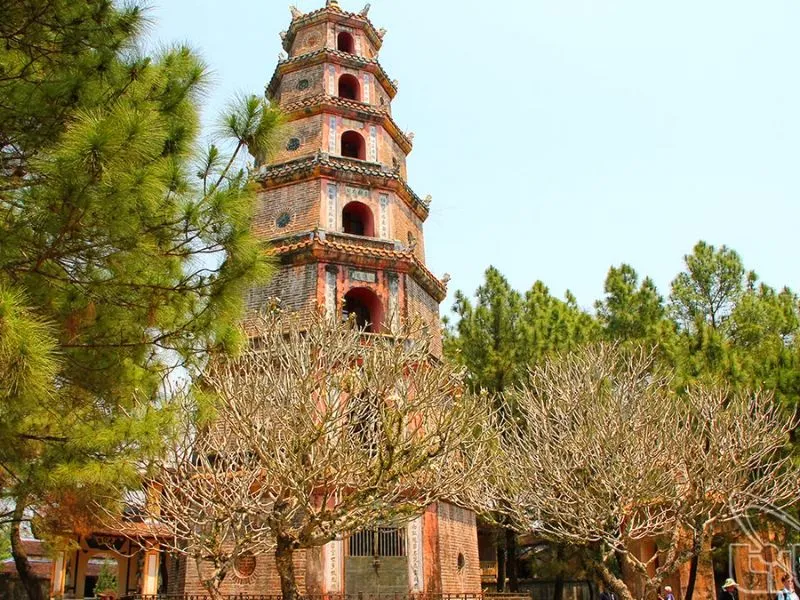
4. Discover the Unique Architecture of Thien Mu Pagoda
Thien Mu Pagoda is not only famous for its history and legends but also attracts tourists with its unique architecture, deeply imbued with Hue style.
4.1. Dai Hung Shrine
Dai Hung Shrine is the main hall of Thien Mu Pagoda, where Maitreya Buddha is worshiped, the Buddha symbolizing joy and peace. The statue of Maitreya Buddha is sculpted with a gentle smile, a large belly showing tolerance, and large ears signifying wisdom. The shrine is built of cement and painted in wood color, creating a feeling of closeness and warmth.
Inside the shrine, there is also a horizontal lacquered board dating back to 1974 and an exquisitely crafted copper sun-moon bell. Inside is the temple for the Three Buddhas, Van Phu Bodhisattva, and Pho Hien. Behind the shrine is the resting place of the late Venerable Thich Don Hau, the abbot who made many contributions to the pagoda’s development.

4.2. Phuoc Duyen Pagoda Tower
Phuoc Duyen Pagoda Tower is the most famous symbol of Thien Mu Pagoda, built in 1844 under the reign of King Thieu Tri. The tower is 21 meters high, with 7 floors, each floor worshiping a Buddha. The tower is built of raw bricks and bluestone, creating a solid and majestic architectural work.
Phuoc Duyen Pagoda Tower is not only a religious architectural work but also a cultural symbol of Hue. The image of Phuoc Duyen Tower has become familiar to Vietnamese people and international tourists, appearing in many travel publications and becoming one of the must-check-in points when visiting Hue.
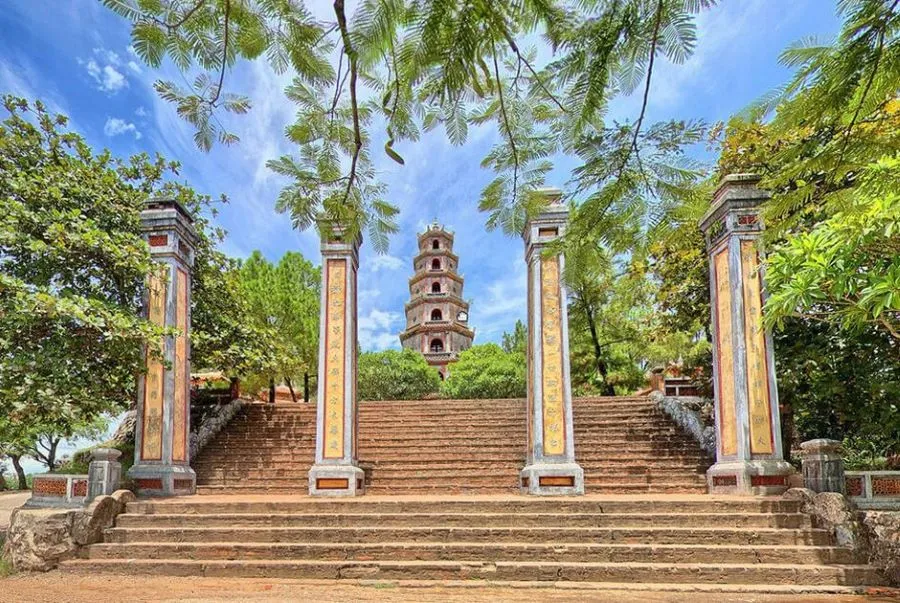
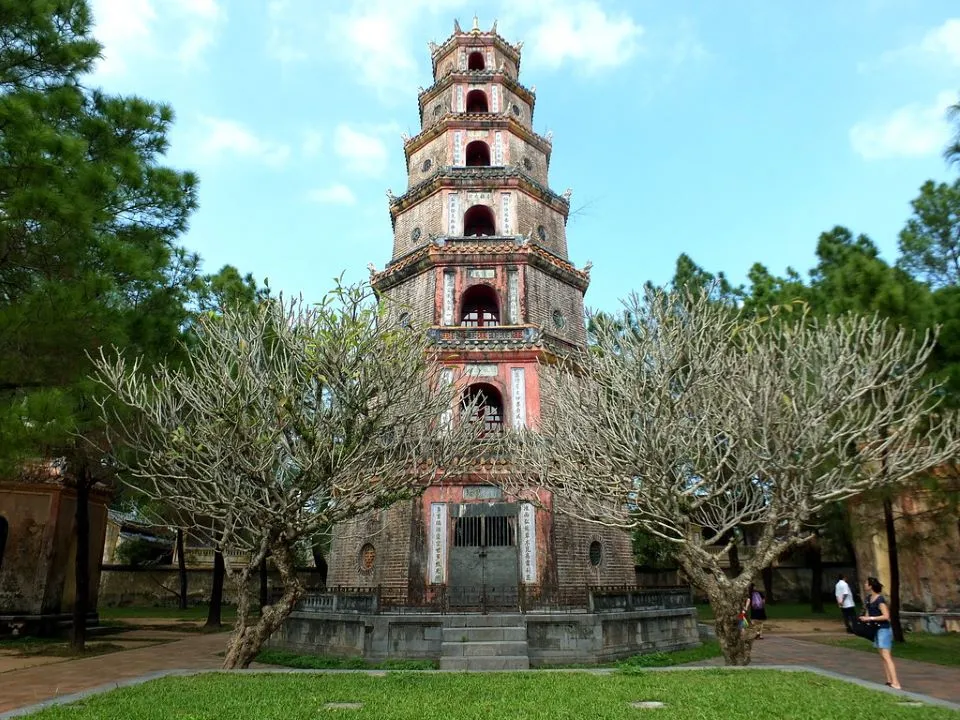
4.3. Tomb Tower Area of the Late Venerable Thich Don Hau
Venerable Thich Don Hau was a famous abbot of Thien Mu Pagoda, who made many contributions to the development of Vietnamese Buddhism and social activities. After his passing, the Venerable was buried in a tomb tower area located at the end of the pagoda’s grounds. The tomb tower area is a simple but solemn architectural work, expressing the people’s respect for the venerable monk.
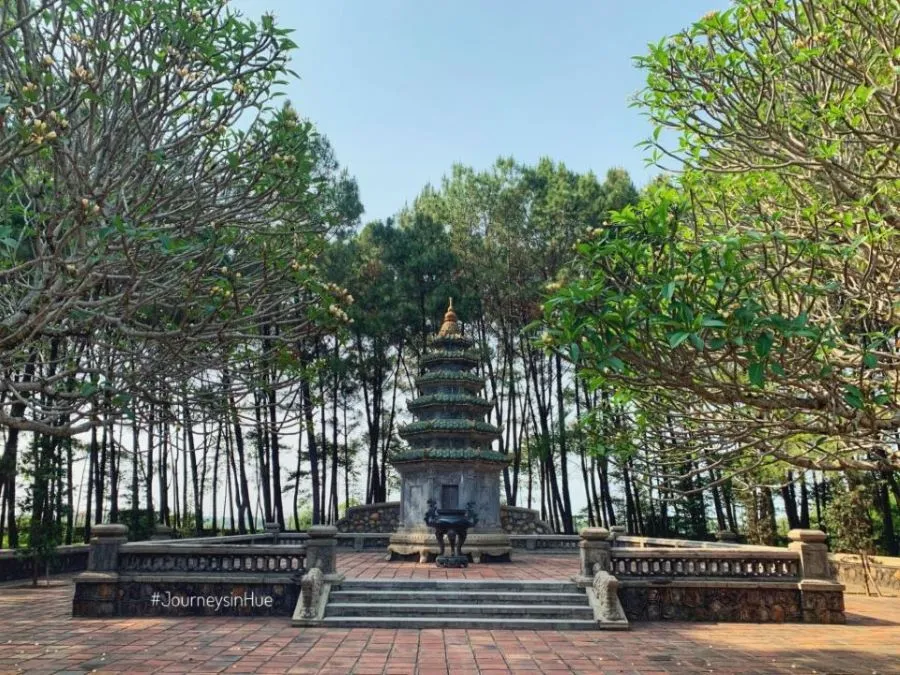
4.4. Tam Quan Gate
The Tam Quan Gate is the main gate of Thien Mu Pagoda, located behind Phuoc Duyen Tower. The gate has three entrances, symbolizing the three realms: Human – Ghost – God. The gate is designed with two tiers and eight roofs, with many unique patterns decorated on the roof peaks. On both sides of the entrance, there are statues of Dharma Protectors guarding, showing the solemnity of the sacred place.
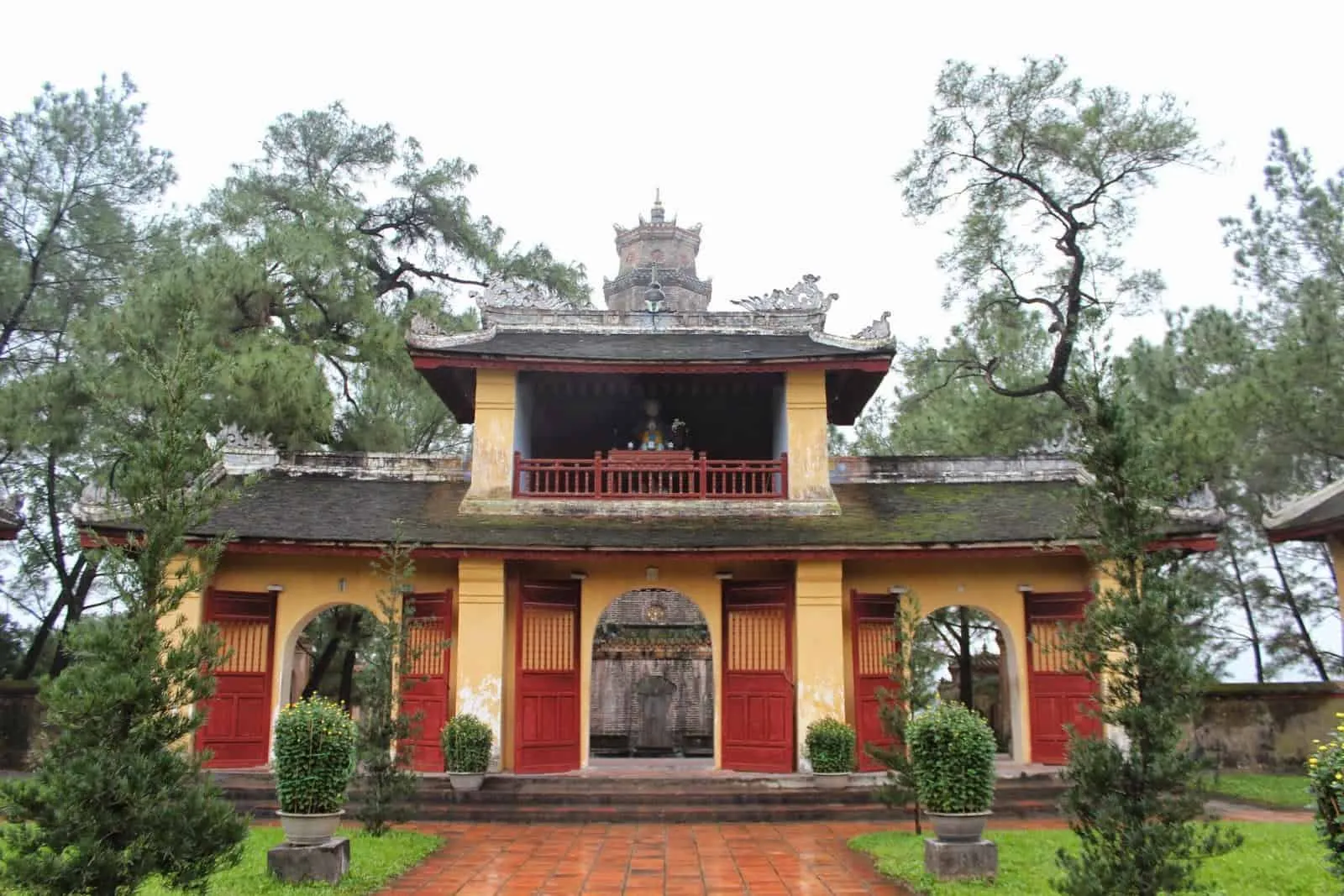
5. Conclusion
Thien Mu Pagoda is not only an ancient pagoda but also a cultural and historical symbol of Hue. With its unique architecture, mysterious stories, and tranquil space, Thien Mu Pagoda is an ideal destination for those who want to learn about Buddhism, explore the beauty of Hue, and find peace in their souls. Come to Thien Mu Pagoda to experience and discover the special cultural, historical, and spiritual values that this pagoda brings.